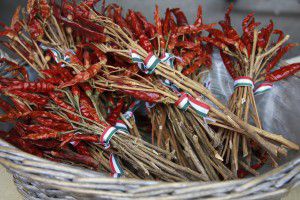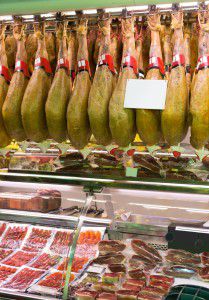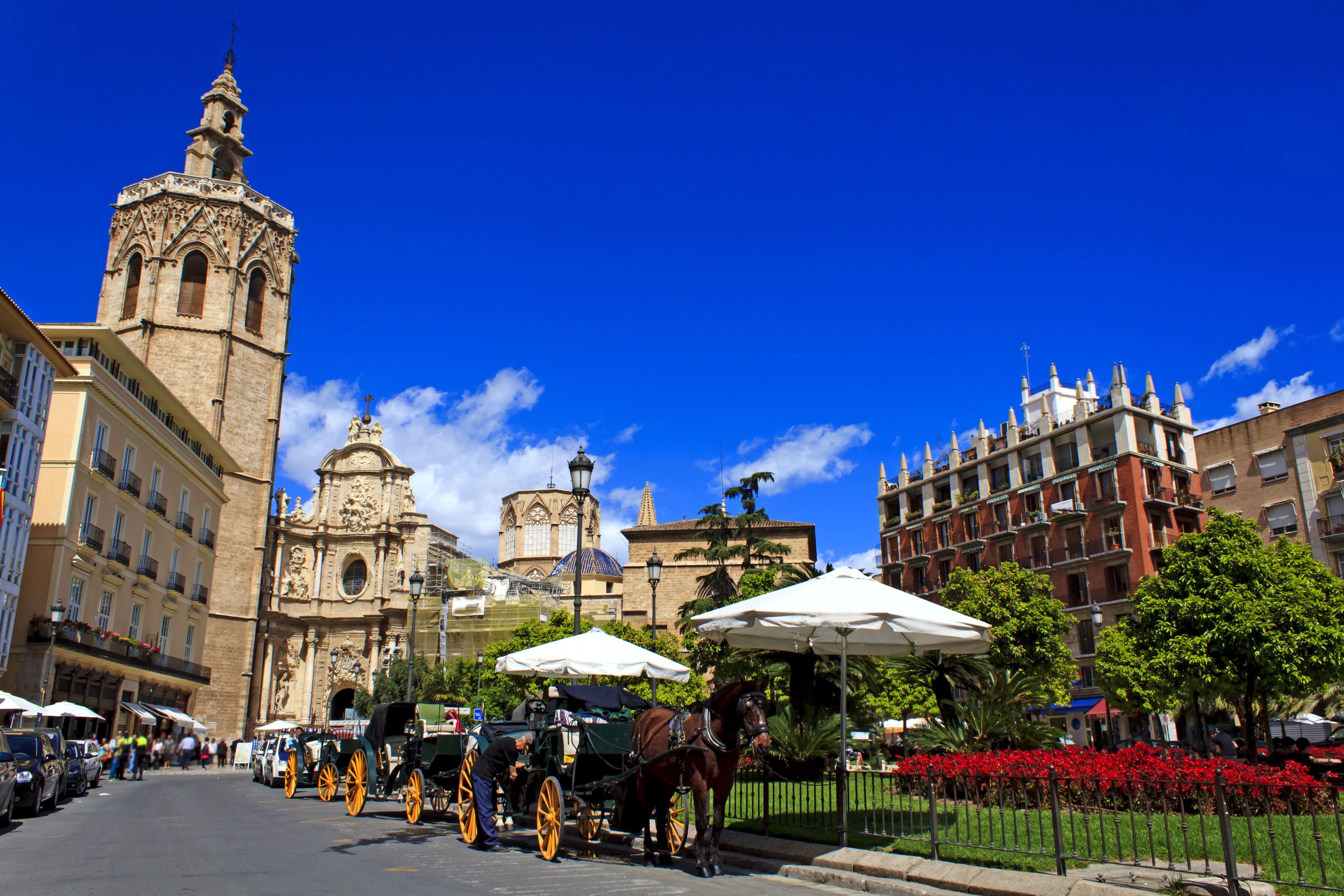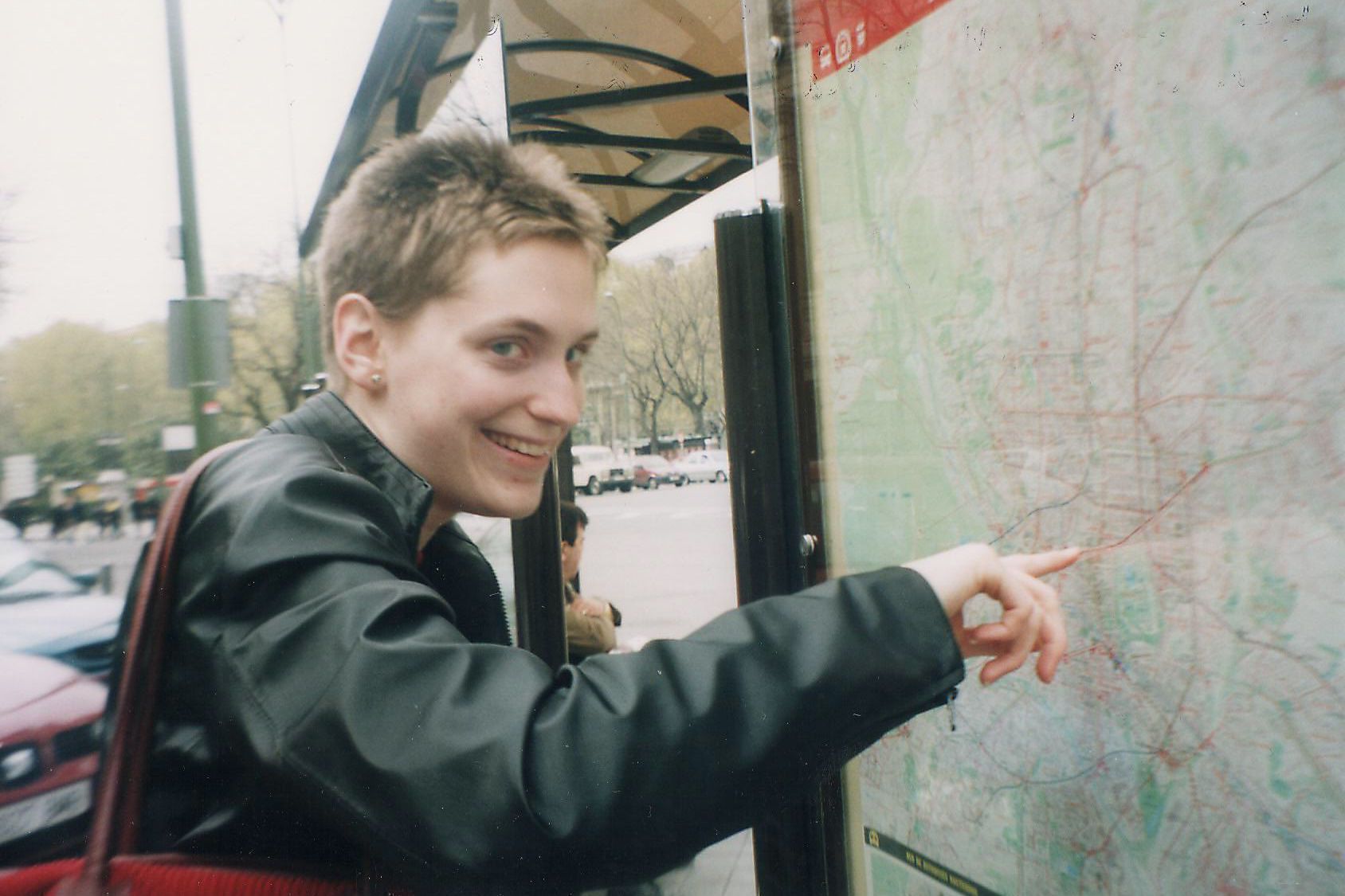Destination: Valencia, Spain
Next up on our list of top holiday destinations is Valencia – here’s Ioana to explain how the Spanish city captured her heart…
The fact that it’s not one of the top touristic destinations in Spain, had me not really knowing what to expect of Valencia. Of course, I was looking forward to amazing paella, sunny skies and tapas, but Valencia has its own special charm that makes it feel like everything that you’d expect of Spain but better. Valencia has surprised me in a delightful way and I want to share my excitement and love for this place.
Not too big and with very good public transport options, it’s a very “manageable” city, as a former local told me. They love bikes over there so if that’s your thing, research on how you can rent a Valenbisi. Walking is a pleasure – beautiful old buildings and orange trees that decorate many of the pavements.
What used to be the bed of the the river Turia was transformed into a huge park with plenty of vegetation, sports courts, fountains and the futuristic looking Calatrava buildings and bridge, collectively called the City of Arts and Sciences, including a planetarium, an oceanarium and an interactive museum. Feeling like you’re about to embark on a spaceship, the beautiful buildings make it hard to take your eyes off them. All white and with bold curves and angles, decorated with light blue water fountains all around, it’s very easy to be impressed by the architect’s talent and vision.
South of the park is the old city centre, which is best explored by foot. All the little streets are beautiful and each neighbourhood has many cafes and bistros where you can take a break and indulge in the delicious Spanish cuisine. One of my favourite places is Plaza de la Reina. The fact that we had some amazing chocolate con churros at one café of the many around the plaza does not influence my decision at all 😉
Where do the cool kids hang out? I hear you ask me. The answer is Russafa. It is the hip neighbourhood with a rich cultural mix which makes it the favourite social place for both tourists and locals. The classic Spanish buildings are home to many restaurants and cafes with delicious pastries. The nightlife here is very lively and is the kind of place where on a hot summer night you might accidentally walk right into a street festival.
In only four days Valencia has managed to make me fall in love with it and quickly climbed and reserved a spot in my top 3 favourite places in the world. Characterful, filled with culture and history, great food, amazing weather and happy palm trees, Valencia surely knows how to impress.
Heading to Spain this summer? Remember to download uTalk before you go so you’re prepared with some basic Spanish conversation!
How did you get your surname?
Do you know how you got your surname?
It is regarded as a tradition for women to take their husband’s surnames when they get married in Britain. It’s also the tradition for men to always be Mr but women will be Miss until they’re married and become Mrs. So if Miss Young married Mr Smith, she would become Mrs Smith. A survey in 1994 showed that 94% of British women decided to take their husband’s surname when married. This ‘tradition’ is no longer as common today, with many women choosing to keep their own surname, or creating a double-barrelled surname.
In Poland many women choose to take their husband’s surname when they get married. However, they have masculine and feminine endings to their surnames. My surname – Koszykowska – like many Polish names ends in ‘ski’ for males or ‘ska’ for females; my dad follows this rule, as does one of my uncles, but the other uncle keeps its simple by using ‘ski’ for his family. It’s thought that originally Polish surnames ending in ‘ski’ or ‘cki’ came from the places where people lived; so if you lived in Wola you would become Wolski.
In Iceland the family name reflects the immediate father’s name or in some cases the mother’s. This is a more complex way of creating a surname compared to the British tradition. If Jón Einarsson had a son called André, André’s surname wouldn’t be Einarsson; instead it would be Jónsson. This is a combination of his father’s first name ‘Jóns’ (the s indicates that he is literally Jón’s son) and the Icelandic word ‘son’. If Jón had a daughter her surname would be Jónsdóttir, dóttir being the Icelandic word for daughter. In some cases they may use the father’s middle name, or their grandfather’s name.
In Spain it’s the norm for children to take the surname of the father and their mother’s maiden name to form one surname. For example if Alejandro López marries Daniela Rodriguez, their child Paula will take the father’s surname López as their second name and their mother’s Rodriguez as their third; Paula López Rodriguez. Then it gets slightly more confusing: if Paula marries she won’t change her surname; instead she will add it to her name. For example, she marries Álvaro Arroyo; her name will become ‘Paula López Rodrigues de Arroyo’. This continues when Paula has children, her mother’s surname will be dropped from their surnames to become ‘López Arroyo’.
Is there an interesting story behind your surname? Let us know!
Alex
10 of the strangest festivals from around the world
Today marks the 70th anniversary of La Tomatina, the famous tomato-throwing festival in Buñol, Spain. La Tomatina began in 1945 but didn’t become an official event until twelve years later. Today, about 30,000 people attend the festival, which begins at around 11am on the last Wednesday of August. Traditionally, the tomato fight can only begin when someone has successfully climbed a greasy pole to retrieve the ham that’s been placed at the top.
We love the idea of La Tomatina, because its only goal is for everyone to have a good time. So we had a look at some of the other unusual events that take place around the world each year; here are a few of our favourites. Please feel free to add your own in the comments!
Moose Dropping Festival, Alaska
This festival ended in 2009, sadly, because it got too big for the town of Talkeetna. But it sounds amazing – essentially it involved numbered moose droppings being dropped from a crane onto targets in the town car park; those that landed closest to the centre of a target won prizes for anyone holding a matching ticket.
Wife Carrying Championships, Finland
Nobody seems quite sure how this bizarre festival originated, although it’s believed to have roots in the 19th century practice of wife-stealing. Competitors carry their wife (or sometimes someone else’s wife) across an obstacle course of over 250 metres, with penalties if they drop her, which seems only fair. The races are run by two teams at once, and the winner is the competitor who completes the course in the quickest time – they get to celebrate with their wife’s weight in beer.
Songkran, Thailand
The Songkran festival is a celebration of the Thai New Year in April, and it’s basically a big water fight. People carry water guns and throw buckets of water over each other, along with white talcum powder. The throwing of water is believed to bring good luck and prosperity for the coming year. But watch out if you’re a tourist, as apparently visitors are a particular target for over-excited locals…
Gulal Throwing Festival, India
The Gulal Throwing Festival takes place each March as part of Holi, which is also known as the festival of colours. And it’s easy to see why – the event involves throwing coloured powder (gulal) and water over each other, so everyone ends up covered in a rainbow of colours. As with Songkran, it’s perfectly acceptable to throw gulal at strangers – the event is all very good-humoured and looks like a lot of fun, if incredibly messy.
World Custard Pie Championships, UK
We didn’t even know this existed, but apparently the World Custard Pie Championships take place every June in Coxheath, Kent. Competing in teams of four, participants try to hit their opponents with custard pies, which they’re only allowed to throw with their left hand. They score one point if they hit an arm, three for the chest and six for a pie in the face. The competition, which began in 1967 as a way to raise funds for the village hall, now attracts teams from across the globe, and was won in 2015 by a team from Japan.
Golden Shears, New Zealand
Every March, competitors come together for the world’s biggest sheep shearing event. Founded in Masterton, New Zealand, in the 1960s, the Golden Shears takes place over three days and includes competitions for all levels in shearing and woolhandling. Sheep shearing requires skill, precision and strength, which makes it an unlikely but no less impressive sporting event.
Boryeong Mud Festival, South Korea
This July festival is essentially a celebration of mud, and in particular its cosmetic benefits. Between events like mud wrestling and mud sliding, you can also enjoy mud massages and the World Mud Skincare Exhibition. According to the website, if you don’t have any mud on your body, you get put in ‘prison’ until you do. In addition, visitors can enjoy the beautiful beach setting of Daechon, and there are games and fireworks as part of the festival too.
Tunarama, Australia
Each January, residents of Port Lincoln, Australia, celebrate the town’s biggest industry – tuna. The free festival includes tuna-themed parades and activities for the whole family. Since 1979, though, the highlight has been the World Championship Tuna Toss, which – as you might expect – involves throwing a tuna as far as you can. This year, the winners were husband and wife Matt and Shanell Staunton from Port Lincoln, who won the men’s and women’s individual events with throws of 24m and 11m respectively.
Hadaka Matsuri (Naked Festival), Japan
One just for the men, which features thousands of nearly-naked participants in a crazy night-time dash across Okayama in Japan. The idea is to catch a pair of sacred sticks (shingi) that have been thrown into the crowd by a priest. It can get a little frantic as the men fight to be first to get hold of the shingi, and competitors are asked to include a slip of paper tucked into their loincloth bearing their name, blood type and emergency contact number, just in case.
Harbin Ice Festival, China
The Harbin Ice Festival takes place in Heilongjiang, in the north-east of China every January, and looks really quite stunning. Participants build life-size buildings and sculptures out of snow and ice, which are then lit up in different colours to create a beautiful ice city. In previous years, the art work has included everything from a fully functional slide to a model of the Sphinx. The festival lasts for a month, but the sculptures can stay up longer, if weather permits.
Have you been to any of these festivals? We’d love to hear about your experience!
Supermarket Swipe
I’m a Morrisons kind of girl.
And when I look longingly into my box of Yorkshire Tea and see nothing but tealeaf dust, I miss it.
I miss a store layout I recognise. I miss being a ble to identify what things are without imaginative guess work and Google Translate. But most of all, I miss English products.
ble to identify what things are without imaginative guess work and Google Translate. But most of all, I miss English products.
When you are far from home and craving custard, and the mere pronunciation of the word ‘vanilla’ fills shop assistants with mirth, you too will experience saudade at the thought of your local supermarket. Because supermarkets abroad sell all manner of things that you would not expect to find. And asking for help when you aren’t exactly sure what you’re asking for is everything from embarrassing to adventurous.
It’s tricky out there.
My fellow Brits abroad: on returning home, don’t be surprised if you feel the sudden urge to run into your nearest supermarket and pull the fishmonger into a tight embrace. Just make sure he doesn’t have a fish filleter in his hand when you do.
Still, never let it be said that there aren’t delightful discoveries to be made Out There. Here is a selection of my own that I haven’t yet decided if I am looking back on with fright or fondness.
China
China might be a bit of an outlier in the joy of supermarket shopping. The ones I went to were the full several-floor ‘we sell everything you can think of and probably some things you have nightmares about’ flavour, with counters offering up an array of unknowns and unidentifiables.
If you are an avid coffee drinker, it might be wise to take a stash of your own. Those crimes-against-coffee all-in-one sachets of coffee, milk powder and sugar are enough to make any coffee aficionado turn and weep.
Something that truly delighted me in Chinese supermarkets (and yes. I am easily amused) was that you can buy milk in pouches. Rather than the cartons we are used to in the UK, milk here – and expect a wide variety of dairy, soya and rice milk – is often sold in these thick, plastic pouches that have a satisfying squishy feeling when you juggle them in your hands. Not that you should really do that. Unless you want an audience.
Hungary
 Hungary is the land of paprika and sour cream. Paprika comes in different strengths of spiciness and there are either ‘regular’ or ‘sweet’ varieties to choose from. Sour cream (tejfol) has all sorts of uses in both sweet and savoury dishes, and you can buy it in all manner of sizes – from the small cartons arranged like pots of fromage frais, to the litres of the stuff in containers the size of those value packs of magnolia paint at B&Q. (It is also apparently a very effective ‘after sun’, but I’m not sure about that.)
Hungary is the land of paprika and sour cream. Paprika comes in different strengths of spiciness and there are either ‘regular’ or ‘sweet’ varieties to choose from. Sour cream (tejfol) has all sorts of uses in both sweet and savoury dishes, and you can buy it in all manner of sizes – from the small cartons arranged like pots of fromage frais, to the litres of the stuff in containers the size of those value packs of magnolia paint at B&Q. (It is also apparently a very effective ‘after sun’, but I’m not sure about that.)
Supermarkets in Hungary are generally smaller than you may be used to at home, but they are pretty well stocked. For some reason, apples are on the pricey side, but the fact that you can buy cherries (both normal and sour, which are delicious) and all manner of berries for a fraction of the price you’d pay at home more than compensates. Another surprising thing is that Spar is an actual supermarket, rather than the emergency-chocolate-fix kind of place that I am used to.
Spain
 Pig legs. Whole pig legs, right down to hoof, are dangled from ceilings and fanned out on counters in enticing displays. This is not a delicacy, but an everyday food product that you will find in many a Spanish kitchen. Ham is so important to Spaniards you could say it is part of the culture. From jamón serrano to jamón york, and a whole spectrum in between, you will never be short of ham if you need it.
Pig legs. Whole pig legs, right down to hoof, are dangled from ceilings and fanned out on counters in enticing displays. This is not a delicacy, but an everyday food product that you will find in many a Spanish kitchen. Ham is so important to Spaniards you could say it is part of the culture. From jamón serrano to jamón york, and a whole spectrum in between, you will never be short of ham if you need it.
For those of you who like to bake, be prepared to make some product replacement choices. Butter and margarine is available here but since most cook and bake with oil instead, and pour oil on their toast in the morning, you might not find exactly what you were looking for.
Alcohol is incredibly cheap here, and very good quality. Good wine is pretty much a given, and when you can buy nice cava for under two euros, or a can of beer for less than 30 cents, you can wonder at how people aren’t walking around constantly merry all day long.
There is a huge range of disposable products in Spanish supermarkets, including napkins, tissues and kitchen roll. And plates, bowls and cups. They even have the ‘balloon’ glasses in plastic form, just in case you decide on a cheeky gin and tonic on an impromptu picnic.
Finland
Our last whistle-stop on the supermarket tour is in the beautiful Finland, with large supermarkets of enough content to satisfy even the most dithering of customers (me). There are more varieties of sausage here than I have ever seen in my life, delicious rye breads, and very good cheese and salami.
One thing that threw me a little was an ‘addition’ to the toilet tissue aisle that I hadn’t anticipated. Since Finland is the land of the sauna, and more importantly, the all-naked sauna, there are disposable sauna ‘tissues seats’ for you to sit on that you can purchase in multipacks, ready for your public sauna experience. If you have your own sauna, and what self-respecting Finn doesn’t, you should of course purchase your own special sauna ‘pad’, which comes in a range of covers, colours and thicknesses. It is a whole new world.
These items might seem like an odd collection of things, and in many ways they are. But on a day when all you want is the home comfort of knowing in which aisle to find a tin of beans, good tea bags, and a bakewell tart, the call of the home supermarket is strong. Especially the bakery aisle. Oh, how I miss the bakery aisle…
Kelly





